Business Finance Report: MDL and Budgeting Approaches
VerifiedAdded on 2023/01/13
|15
|3665
|90
Report
AI Summary
This report provides a comprehensive analysis of business finance, covering key concepts such as profit and cash flow, working capital management, and budgeting approaches. Part 1 focuses on Mediterranean Delights Ltd (MDL), examining its profit and loss statement, balance sheet, cash flow statement, and working capital. It explains the differences between profit and cash flow, the impact of working capital adjustments, and strategies to improve cash flow through better working capital management. Part 2 shifts to budgeting, discussing traditional and alternative approaches, including zero-based budgeting, using Second Sight plc as a case study. The report highlights the purpose of budgeting, explores various budgeting methods, and provides recommendations for financial planning and cost management. The analysis includes detailed calculations, interpretations of financial statements, and practical steps to enhance financial performance and decision-making.
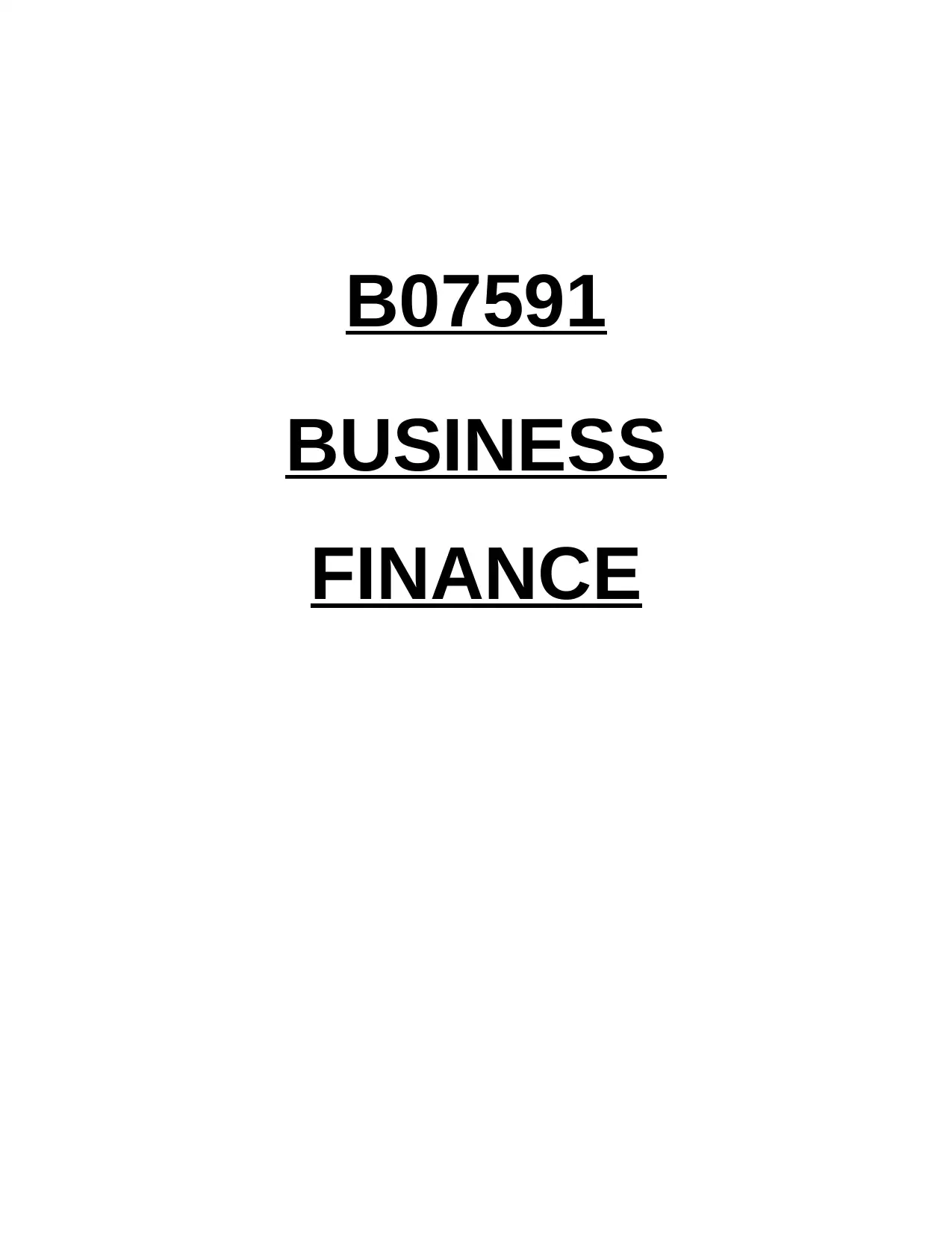
B07591
BUSINESS
FINANCE
BUSINESS
FINANCE
Paraphrase This Document
Need a fresh take? Get an instant paraphrase of this document with our AI Paraphraser
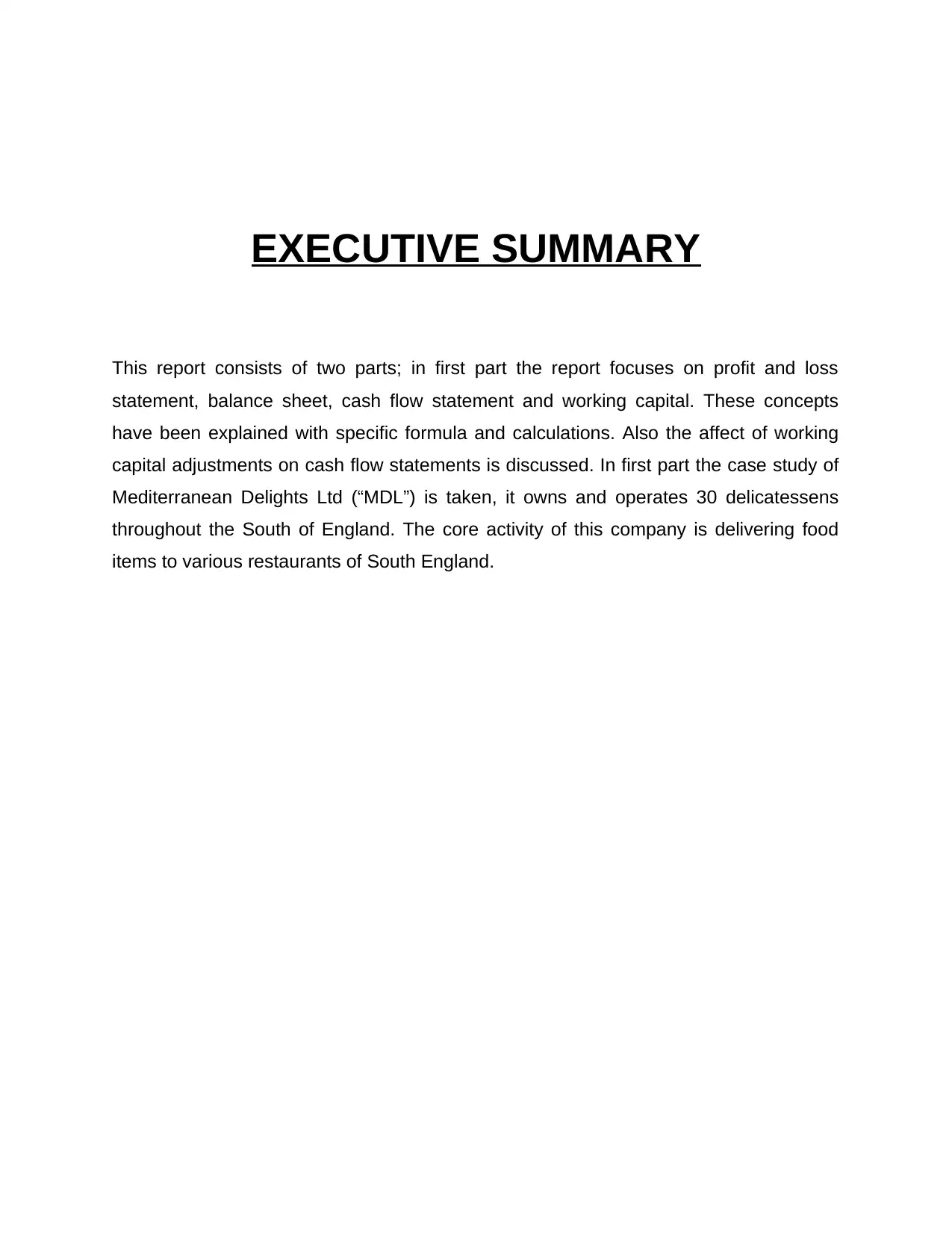
EXECUTIVE SUMMARY
This report consists of two parts; in first part the report focuses on profit and loss
statement, balance sheet, cash flow statement and working capital. These concepts
have been explained with specific formula and calculations. Also the affect of working
capital adjustments on cash flow statements is discussed. In first part the case study of
Mediterranean Delights Ltd (“MDL”) is taken, it owns and operates 30 delicatessens
throughout the South of England. The core activity of this company is delivering food
items to various restaurants of South England.
This report consists of two parts; in first part the report focuses on profit and loss
statement, balance sheet, cash flow statement and working capital. These concepts
have been explained with specific formula and calculations. Also the affect of working
capital adjustments on cash flow statements is discussed. In first part the case study of
Mediterranean Delights Ltd (“MDL”) is taken, it owns and operates 30 delicatessens
throughout the South of England. The core activity of this company is delivering food
items to various restaurants of South England.
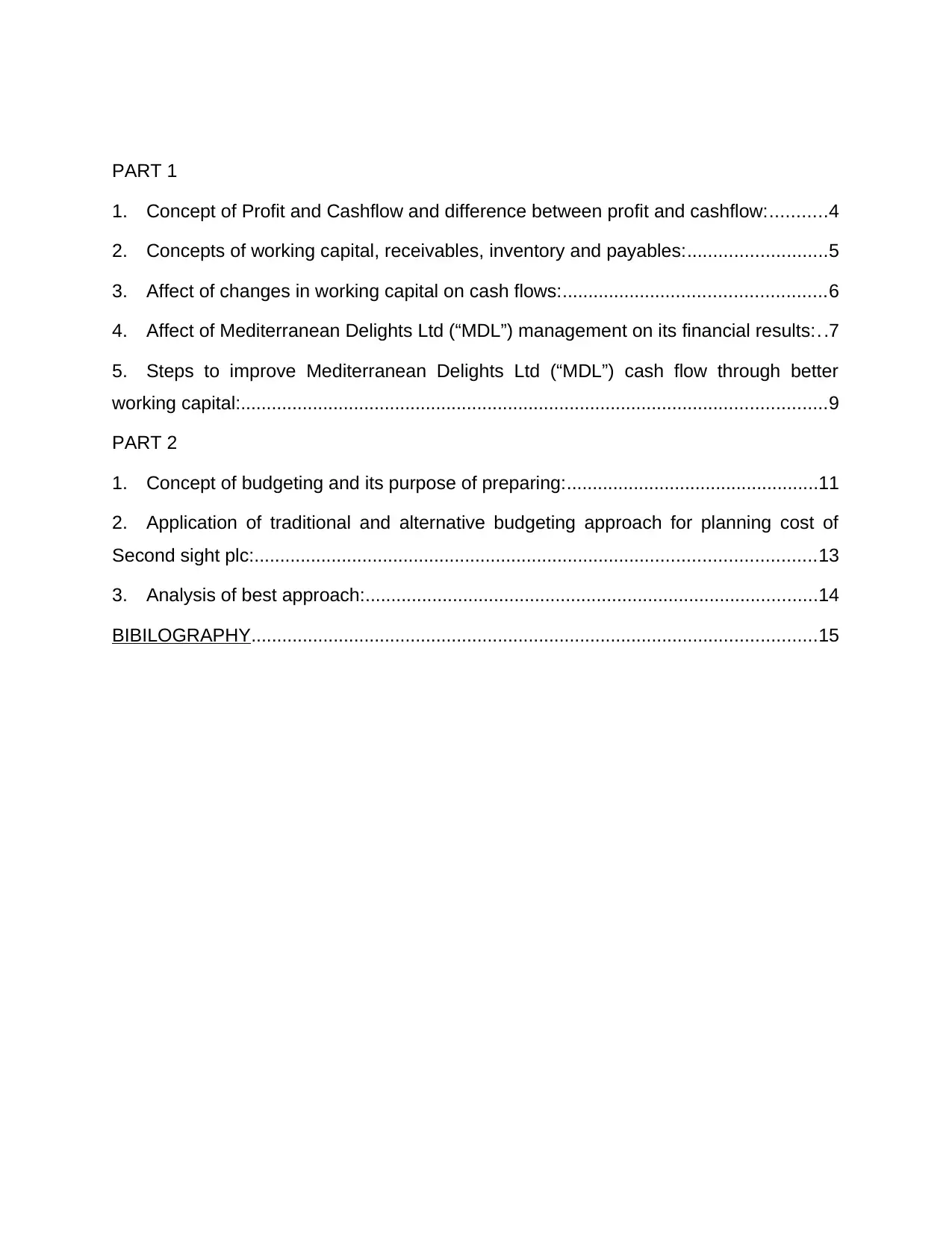
PART 1
1. Concept of Profit and Cashflow and difference between profit and cashflow:...........4
2. Concepts of working capital, receivables, inventory and payables:...........................5
3. Affect of changes in working capital on cash flows:...................................................6
4. Affect of Mediterranean Delights Ltd (“MDL”) management on its financial results:. .7
5. Steps to improve Mediterranean Delights Ltd (“MDL”) cash flow through better
working capital:..................................................................................................................9
PART 2
1. Concept of budgeting and its purpose of preparing:.................................................11
2. Application of traditional and alternative budgeting approach for planning cost of
Second sight plc:.............................................................................................................13
3. Analysis of best approach:........................................................................................14
BIBILOGRAPHY..............................................................................................................15
1. Concept of Profit and Cashflow and difference between profit and cashflow:...........4
2. Concepts of working capital, receivables, inventory and payables:...........................5
3. Affect of changes in working capital on cash flows:...................................................6
4. Affect of Mediterranean Delights Ltd (“MDL”) management on its financial results:. .7
5. Steps to improve Mediterranean Delights Ltd (“MDL”) cash flow through better
working capital:..................................................................................................................9
PART 2
1. Concept of budgeting and its purpose of preparing:.................................................11
2. Application of traditional and alternative budgeting approach for planning cost of
Second sight plc:.............................................................................................................13
3. Analysis of best approach:........................................................................................14
BIBILOGRAPHY..............................................................................................................15
⊘ This is a preview!⊘
Do you want full access?
Subscribe today to unlock all pages.

Trusted by 1+ million students worldwide
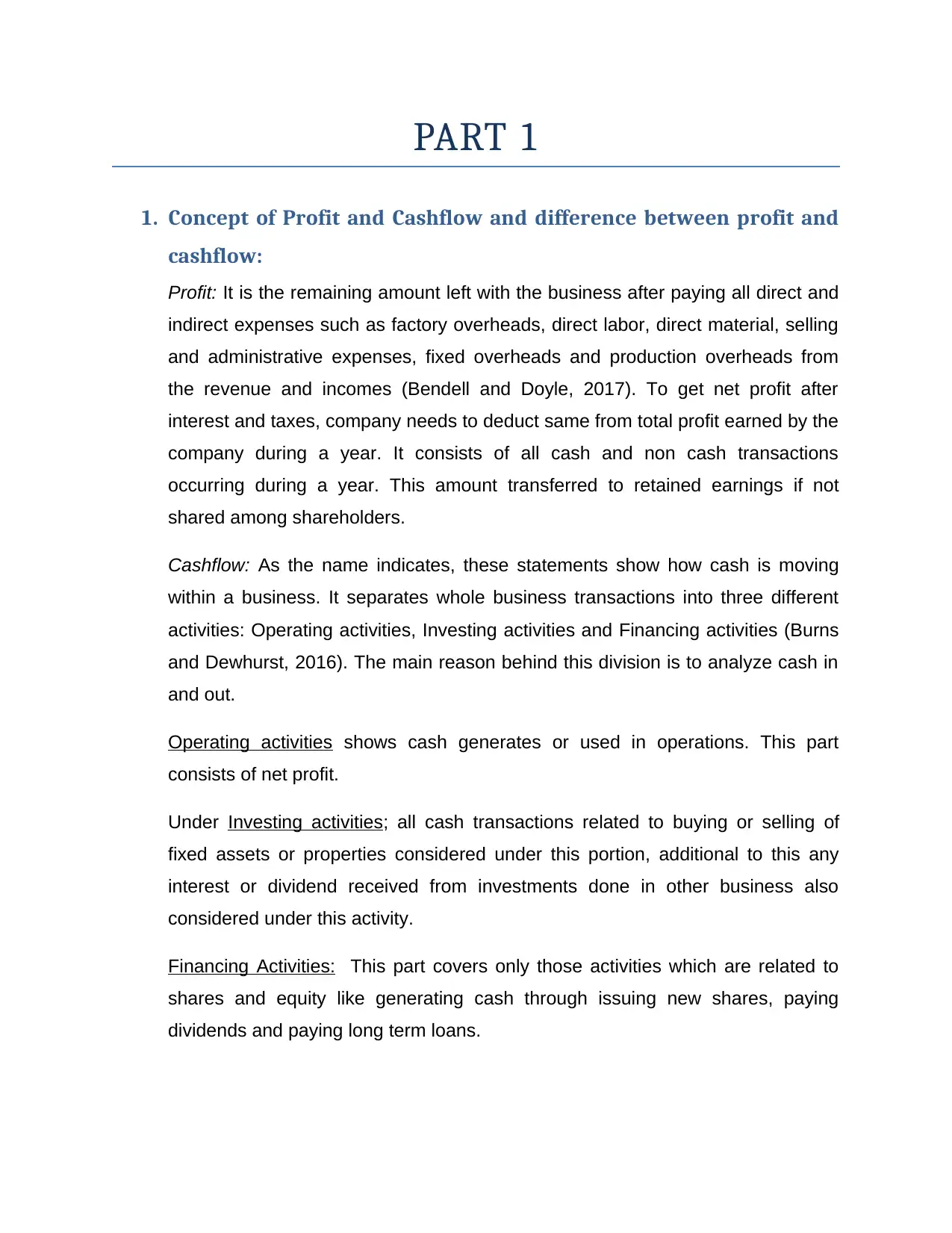
PART 1
1. Concept of Profit and Cashflow and difference between profit and
cashflow:
Profit: It is the remaining amount left with the business after paying all direct and
indirect expenses such as factory overheads, direct labor, direct material, selling
and administrative expenses, fixed overheads and production overheads from
the revenue and incomes (Bendell and Doyle, 2017). To get net profit after
interest and taxes, company needs to deduct same from total profit earned by the
company during a year. It consists of all cash and non cash transactions
occurring during a year. This amount transferred to retained earnings if not
shared among shareholders.
Cashflow: As the name indicates, these statements show how cash is moving
within a business. It separates whole business transactions into three different
activities: Operating activities, Investing activities and Financing activities (Burns
and Dewhurst, 2016). The main reason behind this division is to analyze cash in
and out.
Operating activities shows cash generates or used in operations. This part
consists of net profit.
Under Investing activities; all cash transactions related to buying or selling of
fixed assets or properties considered under this portion, additional to this any
interest or dividend received from investments done in other business also
considered under this activity.
Financing Activities: This part covers only those activities which are related to
shares and equity like generating cash through issuing new shares, paying
dividends and paying long term loans.
1. Concept of Profit and Cashflow and difference between profit and
cashflow:
Profit: It is the remaining amount left with the business after paying all direct and
indirect expenses such as factory overheads, direct labor, direct material, selling
and administrative expenses, fixed overheads and production overheads from
the revenue and incomes (Bendell and Doyle, 2017). To get net profit after
interest and taxes, company needs to deduct same from total profit earned by the
company during a year. It consists of all cash and non cash transactions
occurring during a year. This amount transferred to retained earnings if not
shared among shareholders.
Cashflow: As the name indicates, these statements show how cash is moving
within a business. It separates whole business transactions into three different
activities: Operating activities, Investing activities and Financing activities (Burns
and Dewhurst, 2016). The main reason behind this division is to analyze cash in
and out.
Operating activities shows cash generates or used in operations. This part
consists of net profit.
Under Investing activities; all cash transactions related to buying or selling of
fixed assets or properties considered under this portion, additional to this any
interest or dividend received from investments done in other business also
considered under this activity.
Financing Activities: This part covers only those activities which are related to
shares and equity like generating cash through issuing new shares, paying
dividends and paying long term loans.
Paraphrase This Document
Need a fresh take? Get an instant paraphrase of this document with our AI Paraphraser
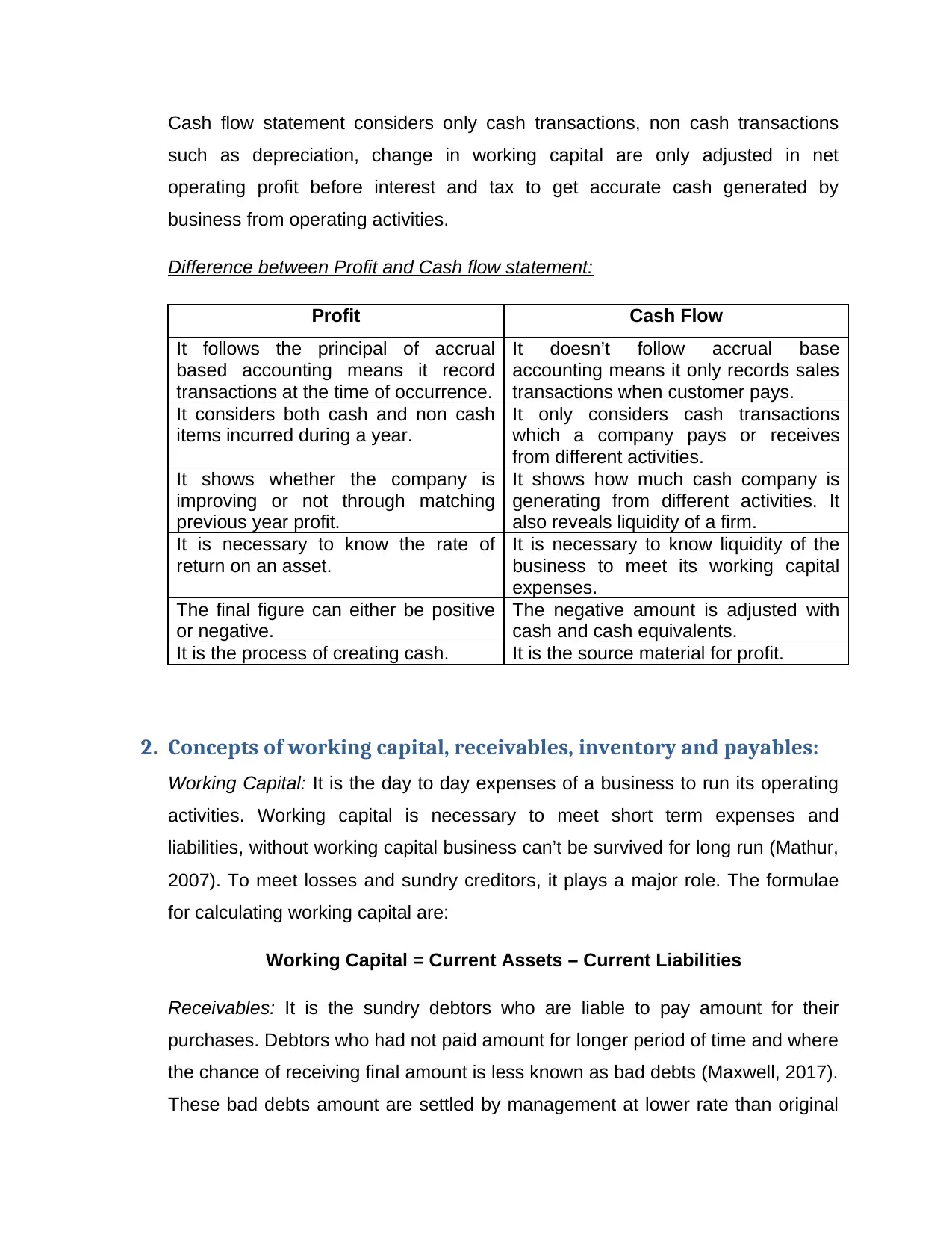
Cash flow statement considers only cash transactions, non cash transactions
such as depreciation, change in working capital are only adjusted in net
operating profit before interest and tax to get accurate cash generated by
business from operating activities.
Difference between Profit and Cash flow statement:
Profit Cash Flow
It follows the principal of accrual
based accounting means it record
transactions at the time of occurrence.
It doesn’t follow accrual base
accounting means it only records sales
transactions when customer pays.
It considers both cash and non cash
items incurred during a year.
It only considers cash transactions
which a company pays or receives
from different activities.
It shows whether the company is
improving or not through matching
previous year profit.
It shows how much cash company is
generating from different activities. It
also reveals liquidity of a firm.
It is necessary to know the rate of
return on an asset.
It is necessary to know liquidity of the
business to meet its working capital
expenses.
The final figure can either be positive
or negative.
The negative amount is adjusted with
cash and cash equivalents.
It is the process of creating cash. It is the source material for profit.
2. Concepts of working capital, receivables, inventory and payables:
Working Capital: It is the day to day expenses of a business to run its operating
activities. Working capital is necessary to meet short term expenses and
liabilities, without working capital business can’t be survived for long run (Mathur,
2007). To meet losses and sundry creditors, it plays a major role. The formulae
for calculating working capital are:
Working Capital = Current Assets – Current Liabilities
Receivables: It is the sundry debtors who are liable to pay amount for their
purchases. Debtors who had not paid amount for longer period of time and where
the chance of receiving final amount is less known as bad debts (Maxwell, 2017).
These bad debts amount are settled by management at lower rate than original
such as depreciation, change in working capital are only adjusted in net
operating profit before interest and tax to get accurate cash generated by
business from operating activities.
Difference between Profit and Cash flow statement:
Profit Cash Flow
It follows the principal of accrual
based accounting means it record
transactions at the time of occurrence.
It doesn’t follow accrual base
accounting means it only records sales
transactions when customer pays.
It considers both cash and non cash
items incurred during a year.
It only considers cash transactions
which a company pays or receives
from different activities.
It shows whether the company is
improving or not through matching
previous year profit.
It shows how much cash company is
generating from different activities. It
also reveals liquidity of a firm.
It is necessary to know the rate of
return on an asset.
It is necessary to know liquidity of the
business to meet its working capital
expenses.
The final figure can either be positive
or negative.
The negative amount is adjusted with
cash and cash equivalents.
It is the process of creating cash. It is the source material for profit.
2. Concepts of working capital, receivables, inventory and payables:
Working Capital: It is the day to day expenses of a business to run its operating
activities. Working capital is necessary to meet short term expenses and
liabilities, without working capital business can’t be survived for long run (Mathur,
2007). To meet losses and sundry creditors, it plays a major role. The formulae
for calculating working capital are:
Working Capital = Current Assets – Current Liabilities
Receivables: It is the sundry debtors who are liable to pay amount for their
purchases. Debtors who had not paid amount for longer period of time and where
the chance of receiving final amount is less known as bad debts (Maxwell, 2017).
These bad debts amount are settled by management at lower rate than original
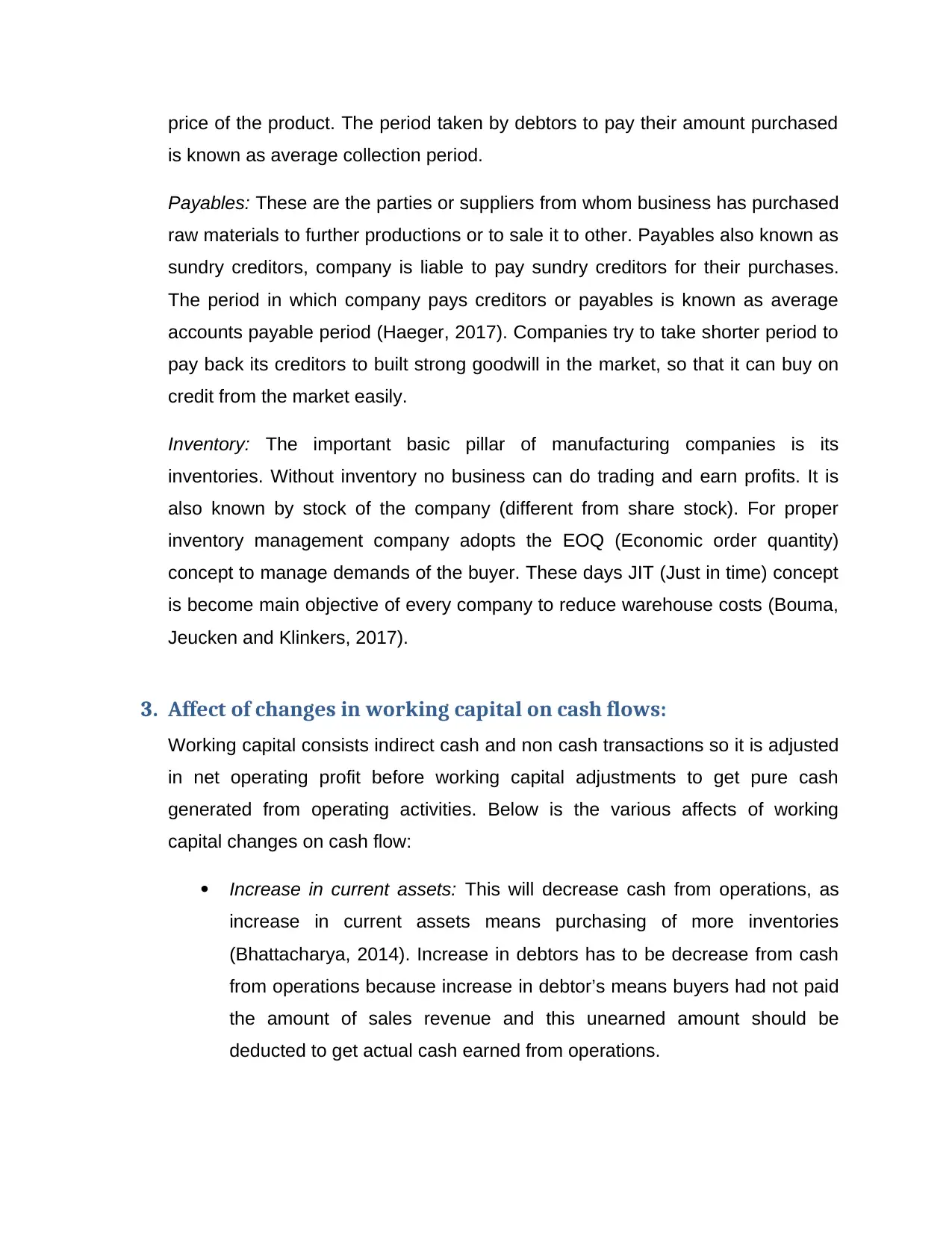
price of the product. The period taken by debtors to pay their amount purchased
is known as average collection period.
Payables: These are the parties or suppliers from whom business has purchased
raw materials to further productions or to sale it to other. Payables also known as
sundry creditors, company is liable to pay sundry creditors for their purchases.
The period in which company pays creditors or payables is known as average
accounts payable period (Haeger, 2017). Companies try to take shorter period to
pay back its creditors to built strong goodwill in the market, so that it can buy on
credit from the market easily.
Inventory: The important basic pillar of manufacturing companies is its
inventories. Without inventory no business can do trading and earn profits. It is
also known by stock of the company (different from share stock). For proper
inventory management company adopts the EOQ (Economic order quantity)
concept to manage demands of the buyer. These days JIT (Just in time) concept
is become main objective of every company to reduce warehouse costs (Bouma,
Jeucken and Klinkers, 2017).
3. Affect of changes in working capital on cash flows:
Working capital consists indirect cash and non cash transactions so it is adjusted
in net operating profit before working capital adjustments to get pure cash
generated from operating activities. Below is the various affects of working
capital changes on cash flow:
Increase in current assets: This will decrease cash from operations, as
increase in current assets means purchasing of more inventories
(Bhattacharya, 2014). Increase in debtors has to be decrease from cash
from operations because increase in debtor’s means buyers had not paid
the amount of sales revenue and this unearned amount should be
deducted to get actual cash earned from operations.
is known as average collection period.
Payables: These are the parties or suppliers from whom business has purchased
raw materials to further productions or to sale it to other. Payables also known as
sundry creditors, company is liable to pay sundry creditors for their purchases.
The period in which company pays creditors or payables is known as average
accounts payable period (Haeger, 2017). Companies try to take shorter period to
pay back its creditors to built strong goodwill in the market, so that it can buy on
credit from the market easily.
Inventory: The important basic pillar of manufacturing companies is its
inventories. Without inventory no business can do trading and earn profits. It is
also known by stock of the company (different from share stock). For proper
inventory management company adopts the EOQ (Economic order quantity)
concept to manage demands of the buyer. These days JIT (Just in time) concept
is become main objective of every company to reduce warehouse costs (Bouma,
Jeucken and Klinkers, 2017).
3. Affect of changes in working capital on cash flows:
Working capital consists indirect cash and non cash transactions so it is adjusted
in net operating profit before working capital adjustments to get pure cash
generated from operating activities. Below is the various affects of working
capital changes on cash flow:
Increase in current assets: This will decrease cash from operations, as
increase in current assets means purchasing of more inventories
(Bhattacharya, 2014). Increase in debtors has to be decrease from cash
from operations because increase in debtor’s means buyers had not paid
the amount of sales revenue and this unearned amount should be
deducted to get actual cash earned from operations.
⊘ This is a preview!⊘
Do you want full access?
Subscribe today to unlock all pages.

Trusted by 1+ million students worldwide
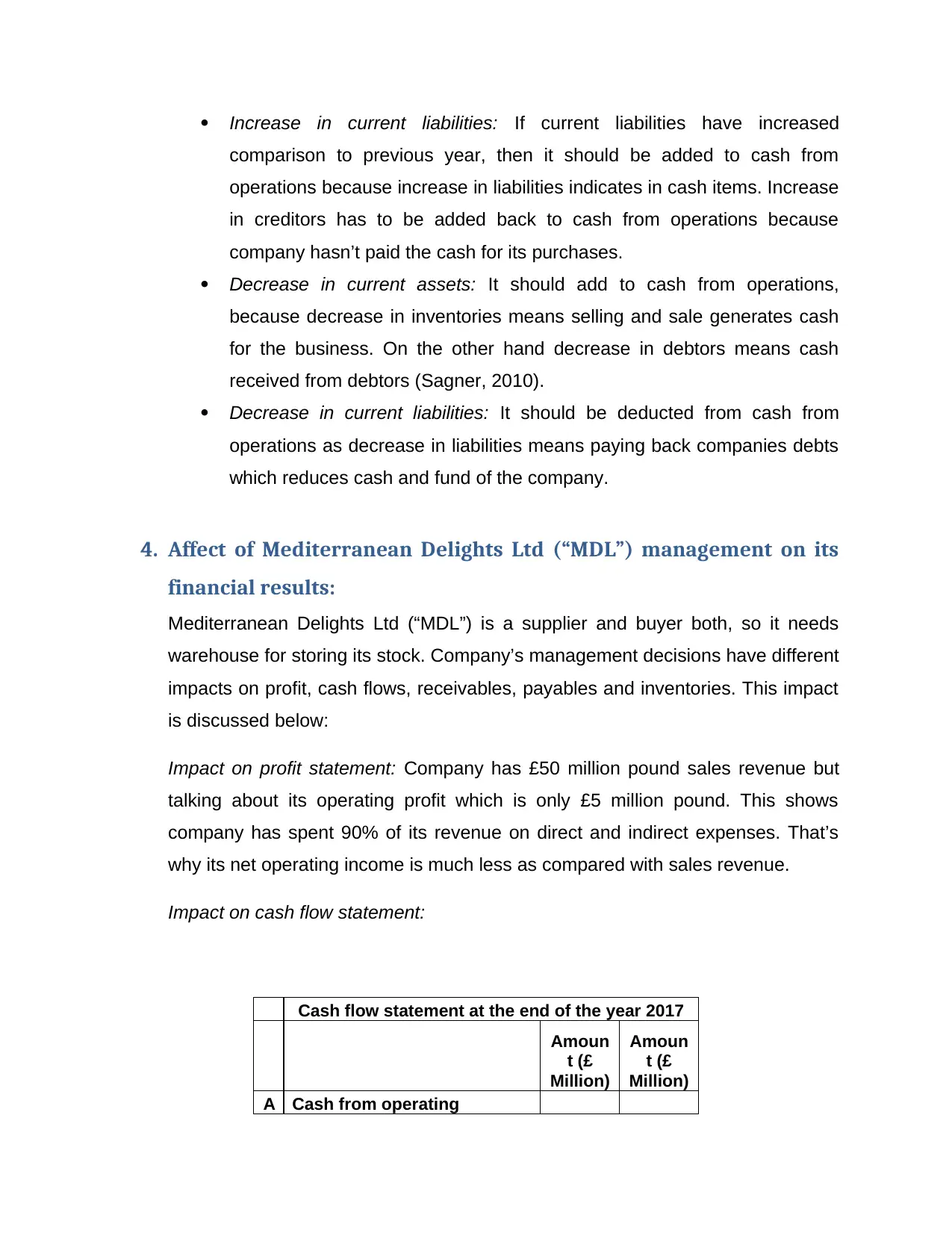
Increase in current liabilities: If current liabilities have increased
comparison to previous year, then it should be added to cash from
operations because increase in liabilities indicates in cash items. Increase
in creditors has to be added back to cash from operations because
company hasn’t paid the cash for its purchases.
Decrease in current assets: It should add to cash from operations,
because decrease in inventories means selling and sale generates cash
for the business. On the other hand decrease in debtors means cash
received from debtors (Sagner, 2010).
Decrease in current liabilities: It should be deducted from cash from
operations as decrease in liabilities means paying back companies debts
which reduces cash and fund of the company.
4. Affect of Mediterranean Delights Ltd (“MDL”) management on its
financial results:
Mediterranean Delights Ltd (“MDL”) is a supplier and buyer both, so it needs
warehouse for storing its stock. Company’s management decisions have different
impacts on profit, cash flows, receivables, payables and inventories. This impact
is discussed below:
Impact on profit statement: Company has £50 million pound sales revenue but
talking about its operating profit which is only £5 million pound. This shows
company has spent 90% of its revenue on direct and indirect expenses. That’s
why its net operating income is much less as compared with sales revenue.
Impact on cash flow statement:
Cash flow statement at the end of the year 2017
Amoun
t (£
Million)
Amoun
t (£
Million)
A Cash from operating
comparison to previous year, then it should be added to cash from
operations because increase in liabilities indicates in cash items. Increase
in creditors has to be added back to cash from operations because
company hasn’t paid the cash for its purchases.
Decrease in current assets: It should add to cash from operations,
because decrease in inventories means selling and sale generates cash
for the business. On the other hand decrease in debtors means cash
received from debtors (Sagner, 2010).
Decrease in current liabilities: It should be deducted from cash from
operations as decrease in liabilities means paying back companies debts
which reduces cash and fund of the company.
4. Affect of Mediterranean Delights Ltd (“MDL”) management on its
financial results:
Mediterranean Delights Ltd (“MDL”) is a supplier and buyer both, so it needs
warehouse for storing its stock. Company’s management decisions have different
impacts on profit, cash flows, receivables, payables and inventories. This impact
is discussed below:
Impact on profit statement: Company has £50 million pound sales revenue but
talking about its operating profit which is only £5 million pound. This shows
company has spent 90% of its revenue on direct and indirect expenses. That’s
why its net operating income is much less as compared with sales revenue.
Impact on cash flow statement:
Cash flow statement at the end of the year 2017
Amoun
t (£
Million)
Amoun
t (£
Million)
A Cash from operating
Paraphrase This Document
Need a fresh take? Get an instant paraphrase of this document with our AI Paraphraser
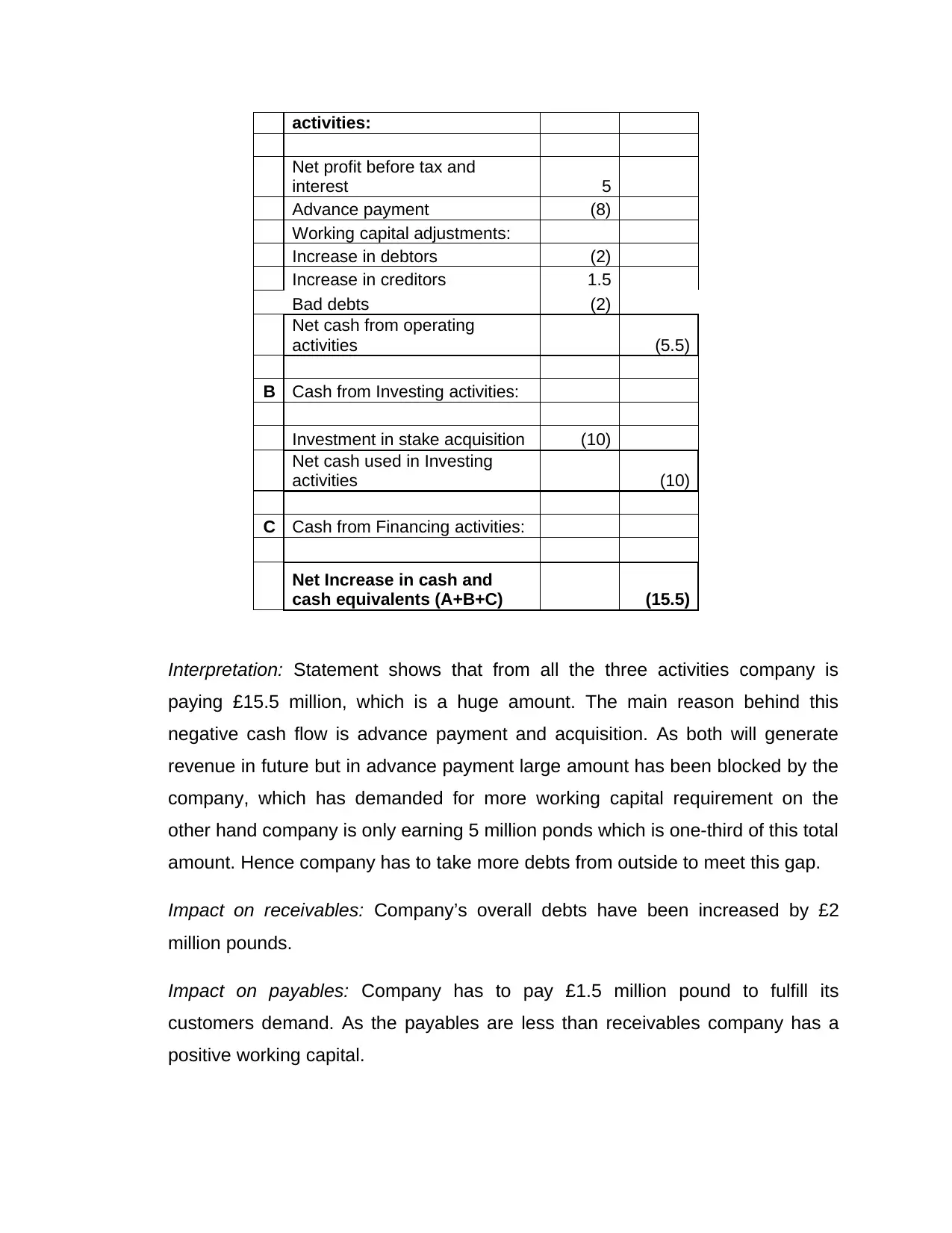
activities:
Net profit before tax and
interest 5
Advance payment (8)
Working capital adjustments:
Increase in debtors (2)
Increase in creditors 1.5
Bad debts (2)
Net cash from operating
activities (5.5)
B Cash from Investing activities:
Investment in stake acquisition (10)
Net cash used in Investing
activities (10)
C Cash from Financing activities:
Net Increase in cash and
cash equivalents (A+B+C) (15.5)
Interpretation: Statement shows that from all the three activities company is
paying £15.5 million, which is a huge amount. The main reason behind this
negative cash flow is advance payment and acquisition. As both will generate
revenue in future but in advance payment large amount has been blocked by the
company, which has demanded for more working capital requirement on the
other hand company is only earning 5 million ponds which is one-third of this total
amount. Hence company has to take more debts from outside to meet this gap.
Impact on receivables: Company’s overall debts have been increased by £2
million pounds.
Impact on payables: Company has to pay £1.5 million pound to fulfill its
customers demand. As the payables are less than receivables company has a
positive working capital.
Net profit before tax and
interest 5
Advance payment (8)
Working capital adjustments:
Increase in debtors (2)
Increase in creditors 1.5
Bad debts (2)
Net cash from operating
activities (5.5)
B Cash from Investing activities:
Investment in stake acquisition (10)
Net cash used in Investing
activities (10)
C Cash from Financing activities:
Net Increase in cash and
cash equivalents (A+B+C) (15.5)
Interpretation: Statement shows that from all the three activities company is
paying £15.5 million, which is a huge amount. The main reason behind this
negative cash flow is advance payment and acquisition. As both will generate
revenue in future but in advance payment large amount has been blocked by the
company, which has demanded for more working capital requirement on the
other hand company is only earning 5 million ponds which is one-third of this total
amount. Hence company has to take more debts from outside to meet this gap.
Impact on receivables: Company’s overall debts have been increased by £2
million pounds.
Impact on payables: Company has to pay £1.5 million pound to fulfill its
customers demand. As the payables are less than receivables company has a
positive working capital.
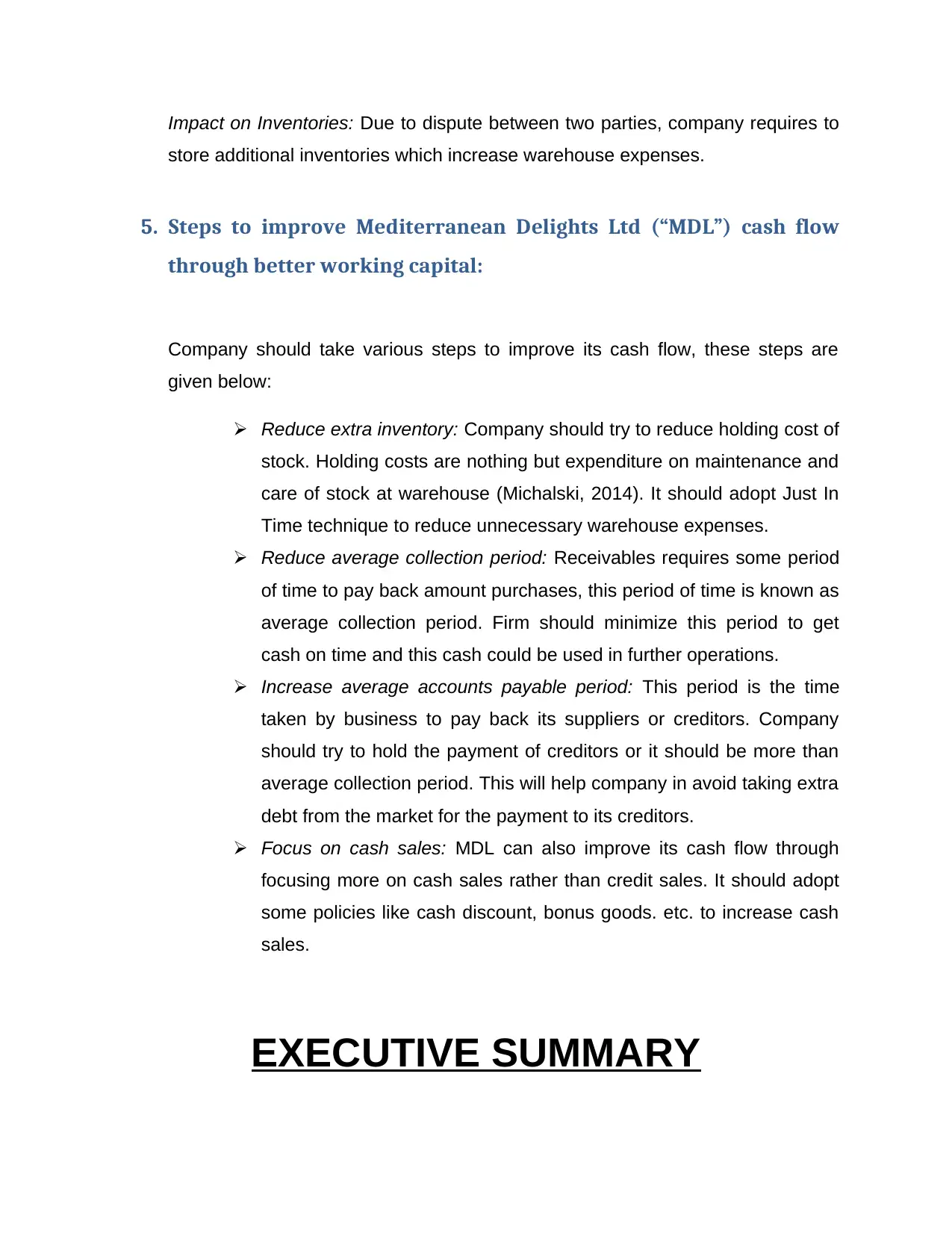
Impact on Inventories: Due to dispute between two parties, company requires to
store additional inventories which increase warehouse expenses.
5. Steps to improve Mediterranean Delights Ltd (“MDL”) cash flow
through better working capital:
Company should take various steps to improve its cash flow, these steps are
given below:
Reduce extra inventory: Company should try to reduce holding cost of
stock. Holding costs are nothing but expenditure on maintenance and
care of stock at warehouse (Michalski, 2014). It should adopt Just In
Time technique to reduce unnecessary warehouse expenses.
Reduce average collection period: Receivables requires some period
of time to pay back amount purchases, this period of time is known as
average collection period. Firm should minimize this period to get
cash on time and this cash could be used in further operations.
Increase average accounts payable period: This period is the time
taken by business to pay back its suppliers or creditors. Company
should try to hold the payment of creditors or it should be more than
average collection period. This will help company in avoid taking extra
debt from the market for the payment to its creditors.
Focus on cash sales: MDL can also improve its cash flow through
focusing more on cash sales rather than credit sales. It should adopt
some policies like cash discount, bonus goods. etc. to increase cash
sales.
EXECUTIVE SUMMARY
store additional inventories which increase warehouse expenses.
5. Steps to improve Mediterranean Delights Ltd (“MDL”) cash flow
through better working capital:
Company should take various steps to improve its cash flow, these steps are
given below:
Reduce extra inventory: Company should try to reduce holding cost of
stock. Holding costs are nothing but expenditure on maintenance and
care of stock at warehouse (Michalski, 2014). It should adopt Just In
Time technique to reduce unnecessary warehouse expenses.
Reduce average collection period: Receivables requires some period
of time to pay back amount purchases, this period of time is known as
average collection period. Firm should minimize this period to get
cash on time and this cash could be used in further operations.
Increase average accounts payable period: This period is the time
taken by business to pay back its suppliers or creditors. Company
should try to hold the payment of creditors or it should be more than
average collection period. This will help company in avoid taking extra
debt from the market for the payment to its creditors.
Focus on cash sales: MDL can also improve its cash flow through
focusing more on cash sales rather than credit sales. It should adopt
some policies like cash discount, bonus goods. etc. to increase cash
sales.
EXECUTIVE SUMMARY
⊘ This is a preview!⊘
Do you want full access?
Subscribe today to unlock all pages.

Trusted by 1+ million students worldwide
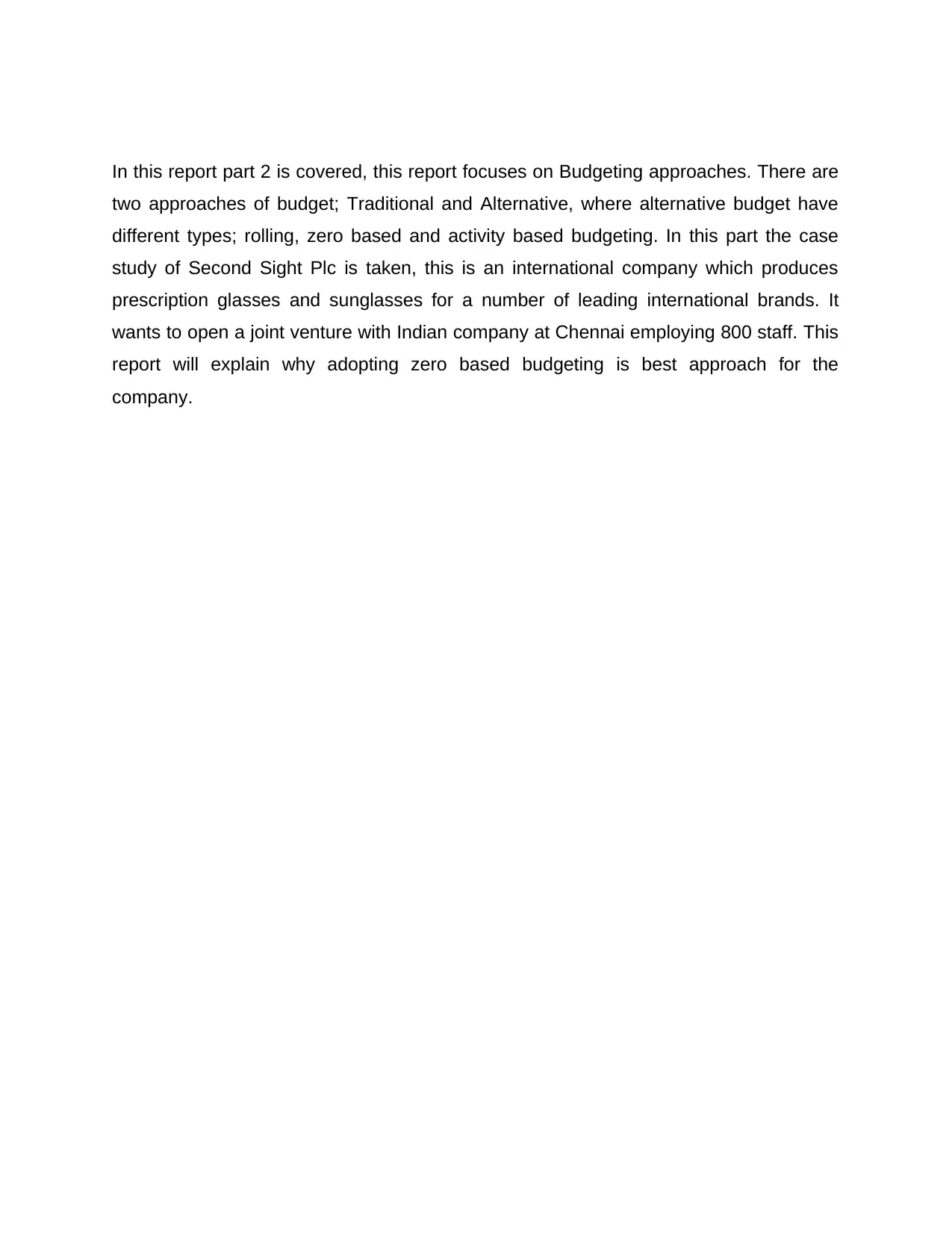
In this report part 2 is covered, this report focuses on Budgeting approaches. There are
two approaches of budget; Traditional and Alternative, where alternative budget have
different types; rolling, zero based and activity based budgeting. In this part the case
study of Second Sight Plc is taken, this is an international company which produces
prescription glasses and sunglasses for a number of leading international brands. It
wants to open a joint venture with Indian company at Chennai employing 800 staff. This
report will explain why adopting zero based budgeting is best approach for the
company.
two approaches of budget; Traditional and Alternative, where alternative budget have
different types; rolling, zero based and activity based budgeting. In this part the case
study of Second Sight Plc is taken, this is an international company which produces
prescription glasses and sunglasses for a number of leading international brands. It
wants to open a joint venture with Indian company at Chennai employing 800 staff. This
report will explain why adopting zero based budgeting is best approach for the
company.
Paraphrase This Document
Need a fresh take? Get an instant paraphrase of this document with our AI Paraphraser
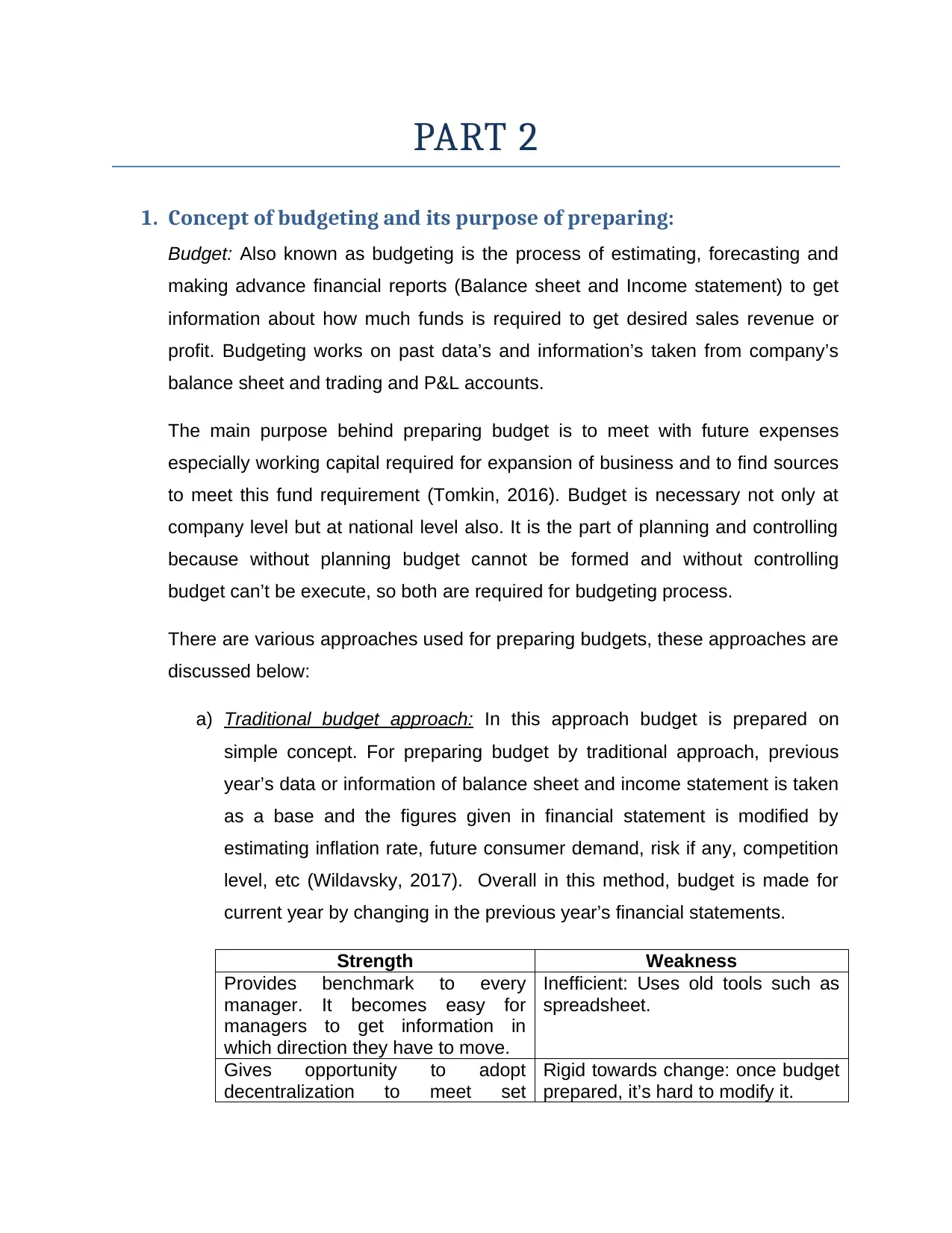
PART 2
1. Concept of budgeting and its purpose of preparing:
Budget: Also known as budgeting is the process of estimating, forecasting and
making advance financial reports (Balance sheet and Income statement) to get
information about how much funds is required to get desired sales revenue or
profit. Budgeting works on past data’s and information’s taken from company’s
balance sheet and trading and P&L accounts.
The main purpose behind preparing budget is to meet with future expenses
especially working capital required for expansion of business and to find sources
to meet this fund requirement (Tomkin, 2016). Budget is necessary not only at
company level but at national level also. It is the part of planning and controlling
because without planning budget cannot be formed and without controlling
budget can’t be execute, so both are required for budgeting process.
There are various approaches used for preparing budgets, these approaches are
discussed below:
a) Traditional budget approach: In this approach budget is prepared on
simple concept. For preparing budget by traditional approach, previous
year’s data or information of balance sheet and income statement is taken
as a base and the figures given in financial statement is modified by
estimating inflation rate, future consumer demand, risk if any, competition
level, etc (Wildavsky, 2017). Overall in this method, budget is made for
current year by changing in the previous year’s financial statements.
Strength Weakness
Provides benchmark to every
manager. It becomes easy for
managers to get information in
which direction they have to move.
Inefficient: Uses old tools such as
spreadsheet.
Gives opportunity to adopt
decentralization to meet set
Rigid towards change: once budget
prepared, it’s hard to modify it.
1. Concept of budgeting and its purpose of preparing:
Budget: Also known as budgeting is the process of estimating, forecasting and
making advance financial reports (Balance sheet and Income statement) to get
information about how much funds is required to get desired sales revenue or
profit. Budgeting works on past data’s and information’s taken from company’s
balance sheet and trading and P&L accounts.
The main purpose behind preparing budget is to meet with future expenses
especially working capital required for expansion of business and to find sources
to meet this fund requirement (Tomkin, 2016). Budget is necessary not only at
company level but at national level also. It is the part of planning and controlling
because without planning budget cannot be formed and without controlling
budget can’t be execute, so both are required for budgeting process.
There are various approaches used for preparing budgets, these approaches are
discussed below:
a) Traditional budget approach: In this approach budget is prepared on
simple concept. For preparing budget by traditional approach, previous
year’s data or information of balance sheet and income statement is taken
as a base and the figures given in financial statement is modified by
estimating inflation rate, future consumer demand, risk if any, competition
level, etc (Wildavsky, 2017). Overall in this method, budget is made for
current year by changing in the previous year’s financial statements.
Strength Weakness
Provides benchmark to every
manager. It becomes easy for
managers to get information in
which direction they have to move.
Inefficient: Uses old tools such as
spreadsheet.
Gives opportunity to adopt
decentralization to meet set
Rigid towards change: once budget
prepared, it’s hard to modify it.
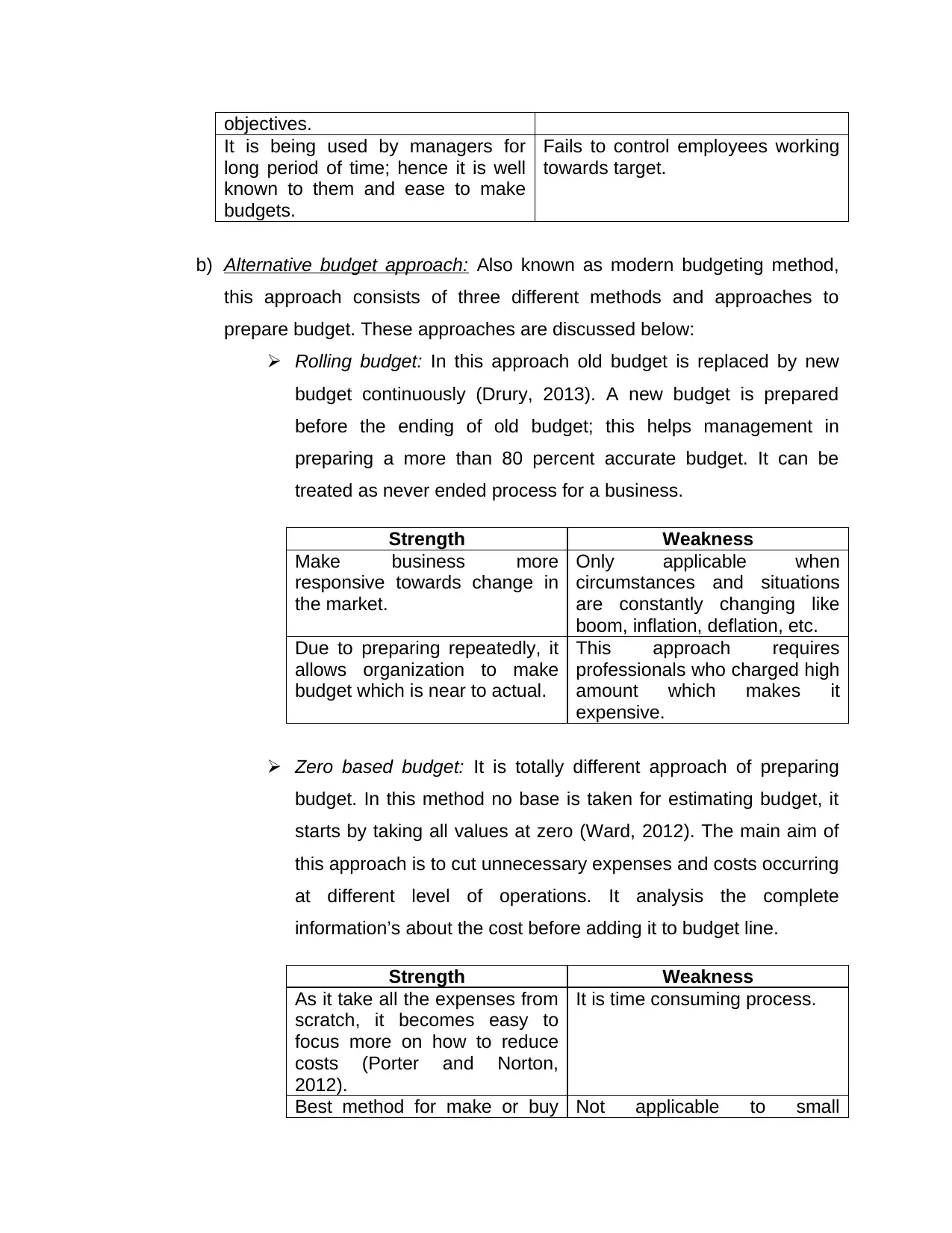
objectives.
It is being used by managers for
long period of time; hence it is well
known to them and ease to make
budgets.
Fails to control employees working
towards target.
b) Alternative budget approach: Also known as modern budgeting method,
this approach consists of three different methods and approaches to
prepare budget. These approaches are discussed below:
Rolling budget: In this approach old budget is replaced by new
budget continuously (Drury, 2013). A new budget is prepared
before the ending of old budget; this helps management in
preparing a more than 80 percent accurate budget. It can be
treated as never ended process for a business.
Strength Weakness
Make business more
responsive towards change in
the market.
Only applicable when
circumstances and situations
are constantly changing like
boom, inflation, deflation, etc.
Due to preparing repeatedly, it
allows organization to make
budget which is near to actual.
This approach requires
professionals who charged high
amount which makes it
expensive.
Zero based budget: It is totally different approach of preparing
budget. In this method no base is taken for estimating budget, it
starts by taking all values at zero (Ward, 2012). The main aim of
this approach is to cut unnecessary expenses and costs occurring
at different level of operations. It analysis the complete
information’s about the cost before adding it to budget line.
Strength Weakness
As it take all the expenses from
scratch, it becomes easy to
focus more on how to reduce
costs (Porter and Norton,
2012).
It is time consuming process.
Best method for make or buy Not applicable to small
It is being used by managers for
long period of time; hence it is well
known to them and ease to make
budgets.
Fails to control employees working
towards target.
b) Alternative budget approach: Also known as modern budgeting method,
this approach consists of three different methods and approaches to
prepare budget. These approaches are discussed below:
Rolling budget: In this approach old budget is replaced by new
budget continuously (Drury, 2013). A new budget is prepared
before the ending of old budget; this helps management in
preparing a more than 80 percent accurate budget. It can be
treated as never ended process for a business.
Strength Weakness
Make business more
responsive towards change in
the market.
Only applicable when
circumstances and situations
are constantly changing like
boom, inflation, deflation, etc.
Due to preparing repeatedly, it
allows organization to make
budget which is near to actual.
This approach requires
professionals who charged high
amount which makes it
expensive.
Zero based budget: It is totally different approach of preparing
budget. In this method no base is taken for estimating budget, it
starts by taking all values at zero (Ward, 2012). The main aim of
this approach is to cut unnecessary expenses and costs occurring
at different level of operations. It analysis the complete
information’s about the cost before adding it to budget line.
Strength Weakness
As it take all the expenses from
scratch, it becomes easy to
focus more on how to reduce
costs (Porter and Norton,
2012).
It is time consuming process.
Best method for make or buy Not applicable to small
⊘ This is a preview!⊘
Do you want full access?
Subscribe today to unlock all pages.

Trusted by 1+ million students worldwide
1 out of 15
Related Documents
Your All-in-One AI-Powered Toolkit for Academic Success.
+13062052269
info@desklib.com
Available 24*7 on WhatsApp / Email
![[object Object]](/_next/static/media/star-bottom.7253800d.svg)
Unlock your academic potential
Copyright © 2020–2025 A2Z Services. All Rights Reserved. Developed and managed by ZUCOL.





